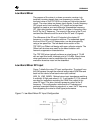
SWRA004A
TRF1500 Integrated Dual-Band RF Receiver User’s Guide 23
Low-Band Mixer LO Input
Figure 8 details the low-band mixer LO input configuration. The
input power range level for the LO buffer amplifier is flexible
enough (-3 dBm to -7 dBm) to drive the mixer without entering
compression. The LO signal is injected through an internal LO
buffer amplifier and into the mixer. A high pass shunt-L (L14) and
series-C (C17) network is used for impedance matching. The
inductor also shunts to ground any undesired noise that could be
injected to the mixer.
Figure 8. Low-Band Mixer LO Input Configuration
Low-Band IF Output
Figure 9 details the low-band IF output configuration. The low-
band mixer has a differential IF output with a 1k
Ω
differential
output impedance. For evaluation, a 16:1 transformer balun, with
a insertion loss of 1.8 dB, is used to transform the 1k
Ω
differential
output to a single-ended output which is then matched to 50
Ω
. In
the actual application, the IF output is usually connected to a
narrow band channel select filter with a differential input and the
transformer balun is not required.
The supply voltage (VCC) is applied to the IF pins with pull up
inductors (L12, L13). A low-pass filter network is provided prior to
the balun. The filter also acts as part of the impedance matching
network. During optimization of the output matching network, it
was found that mismatching the differential output, accomplished
with C55, gives the best IIP3 performance with minimum effect on
the gain and noise figure performance. C55 also helps to
decouple the digital CMOS control line from the LO signal. The IF
response is shaped by the shunt-L (L51) after the transformer
balun. L51 is also used to block unwanted noise that could be
reflected back to the mixer. The series capacitor (C51) near the
LB_IF_OUT port is used as a dc block for evaluation purposes
and does not have to be implemented in the end-users system.


















